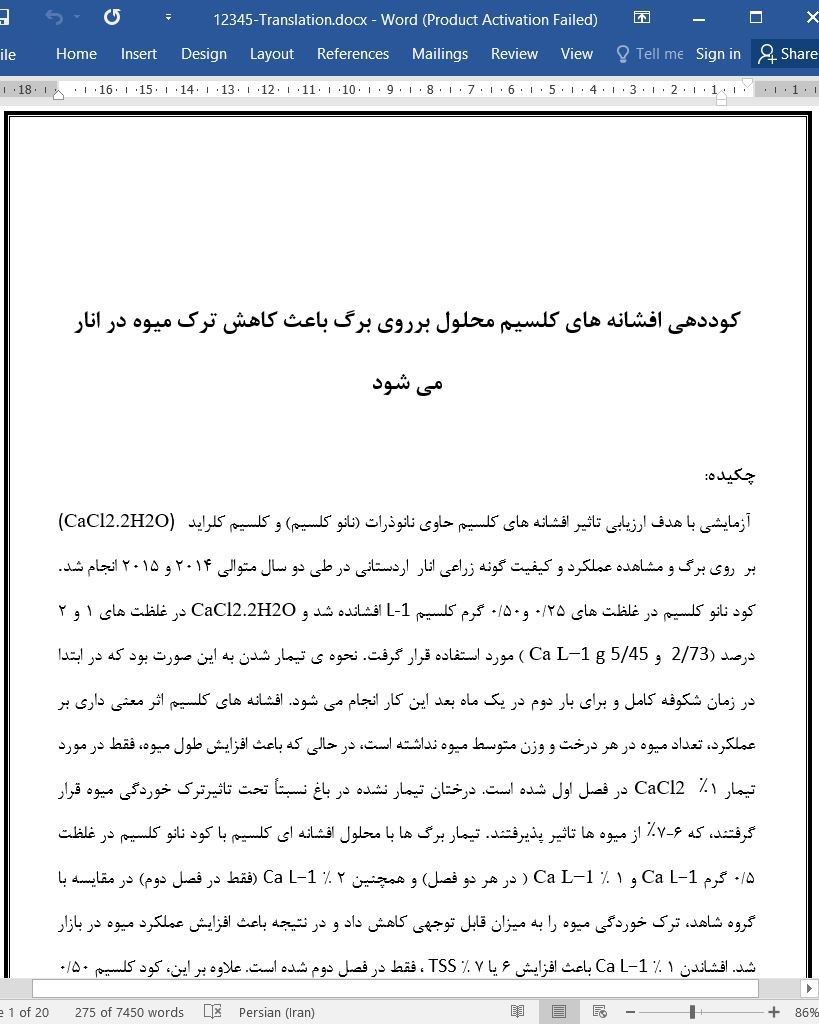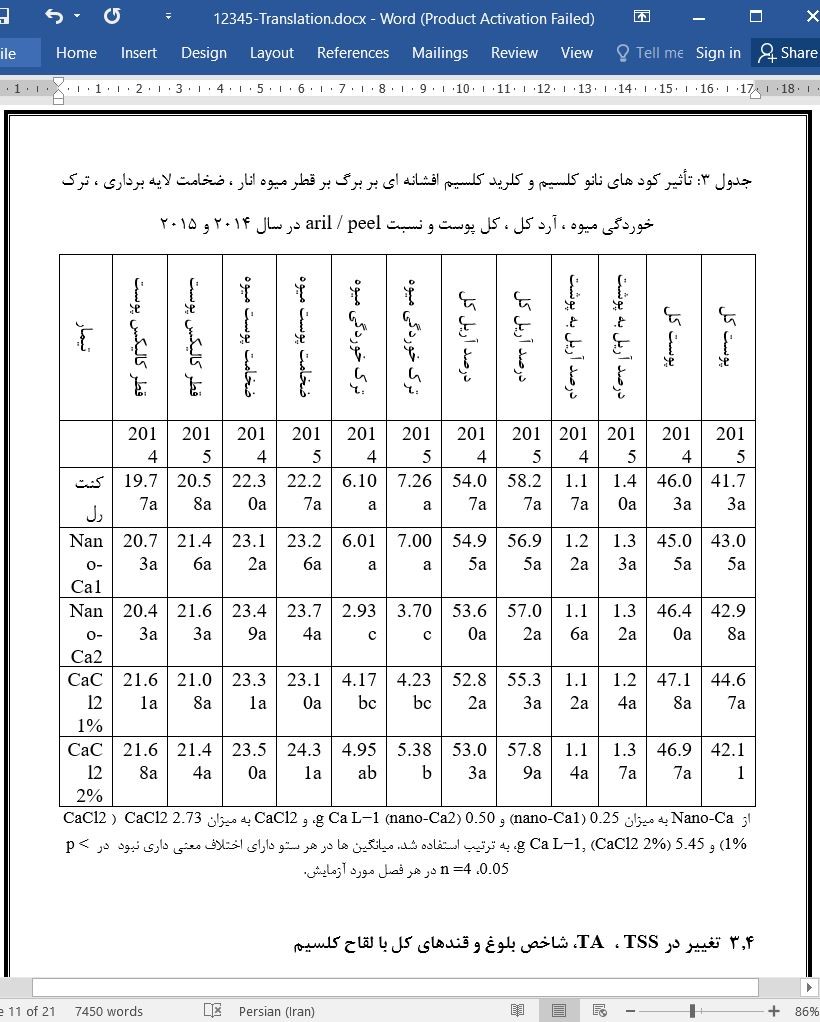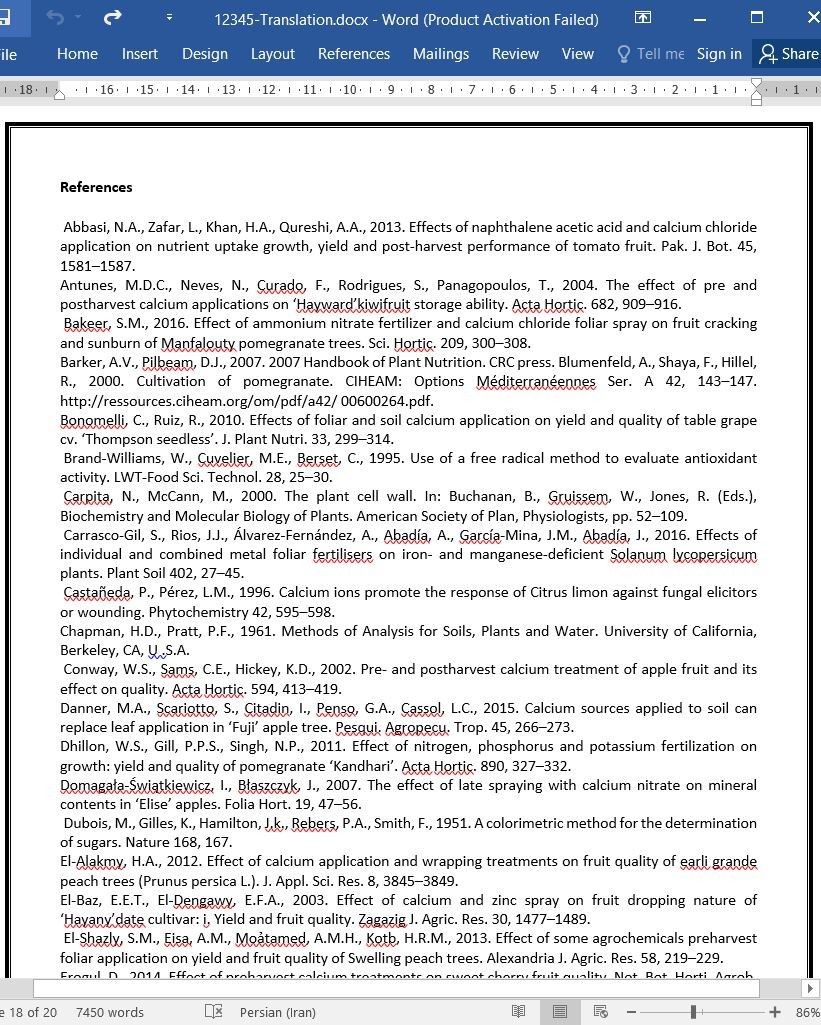
کوددهی افشانه های کلسیم محلول برروی برگ باعث کاهش ترک میوه در انار می شود
چکیده
آزمايشي با هدف ارزيابي تاثير افشانه هاي كلسيم حاوي نانوذرات (نانو كلسيم) و كلسيم کلراید (CaCl2.2H2O) بر روی برگ و مشاهده عملكرد و كيفيت گونه زراعی انار اردستانی در طی دو سال متوالی 2014 و 2015 انجام شد. کود نانو کلسیم در غلظت های 25/0 و50/0 گرم کلسیم L-1 افشانده شد و CaCl2.2H2O در غلظت های 1 و 2 درصد (2/73 و5/45 g Ca L−1) مورد استفاده قرار گرفت. نحوه ی تیمار شدن به این صورت بود که در ابتدا در زمان شکوفه کامل و برای بار دوم در یک ماه بعد این کار انجام می شود. افشانه های کلسیم اثر معنی داری بر عملکرد، تعداد میوه در هر درخت و وزن متوسط میوه نداشته است، در حالی که باعث افزایش طول میوه، فقط در مورد تیمار 1٪ CaCl2 در فصل اول شده است. درختان تیمار نشده در باغ نسبتاً تحت تاثیرترک خوردگی میوه قرار گرفتند، که 6-7٪ از میوه ها تاثیر پذیرفتند. تیمار برگ ها با محلول افشانه ای کلسیم با کود نانو کلسیم در غلظت 5/0 گرم Ca L−1 و 1 % Ca L−1 ( در هر دو فصل) و همچنین 2 % Ca L−1 (فقط در فصل دوم) در مقایسه با گروه شاهد، ترک خوردگی میوه را به میزان قابل توجهی کاهش داد و در نتیجه باعث افزایش عملکرد میوه در بازار شد. افشاندن 1 % Ca L−1 باعث افزایش 6 یا 7 % TSS ، فقط در فصل دوم شده است. علاوه بر این، کود کلسیم 50/0 گرم Ca L−1 منجر به کاهش جزئی (تقریبا 1٪) در کل فنل ها فقط در فصل اول شد. سایر خصوصیات شیمیایی، از جمله اسیدیته قابل اندازه گیری، بلوغ میوه، قند کل، فعالیت آنتی اکسیدانی و محتوای آنتوسیانین کل در لقاح کلسیم تحت تأثیر قرار نگرفت. تجزیه و تحلیل برگ نشان می دهد که تیمارهای برگ باعث افزایش غلظت کلسیم برگ در فصل اول، به استثنای دوز کم کود نانو، شده است؛ در حالی که غلظت برگ های N ، P ، K ، آهن، روی و منگنز بی تاثیر بودند. به طور خلاصه، باروری با غلظت کم (50/0 g CaCl2) کلسیم در فرمول نانو کلسیم منجر به کاهش مشابه در ترک خوردگی میوه انار نسبت به موارد به دست آمده با دوزهای بالاتر CaCl2 شد ( 73/2 و 45/5 g CaCl2).
1- معرفی
انار (Punica granatum L.) یکی از قدیمی ترین میوه های خوراکی شناخته شده است که بومی ایران است و در حال حاضر در بسیاری از کشورها از جمله اسپانیا، مراکش، مصر، افغانستان، برمه، چین، ژاپن، آمریکا، روسیه، بلغارستان و ایتالیا انار عمدتا به عنوان یک میوه تازه مصرف می شود و از آن به شکل مربا، آب میوه، شراب، سرکه و ژله نیز استفاده می شود (Heber et al., 2006; Kingsly and Singh, 2007; Sheikh and Manjula, 2012; Gumienna et al., 2016)
5- نتیجه گیری
نتایج به دست آمده از مطالعه حاضر نشان می دهد که کود دهی به عنوان اسپری بر روی برگ ها در شکوفه های کامل و یک ماه بعد باعث کاهش معنی دار ترک خوردگی میوه و کاهش اختلال در یک باغ متوسط (6-7٪ از میوه ها) می شود. نتایج نشان می دهد که لقاح کلسیم منجر به کاهش 26- 52 درصدی ترک خوردگی میوه در دو فصل مختلف در مقایسه با شاهد می شود که بهترین اثر آن با کود نانو کلسیم در 50/0 گرم کلسیم است. کوددهی کلسیم برروی برگ هیچ تاثیری در عملکرد میوه انار ، تعداد میوه در هر درخت ، وزن متوسط میوه ، TA ، بلوغ میوه ، قندهای کل ، فعالیت آنتی اکسیدانی و آنتوسیانین های کل نداشت. در دوره اول ، ميوه 9٪ با تيمار CaCl2٪ 1 در فصل اول افزايش يافت و اثرات كمتري بر روي فنل هاي كل (1٪ با تيمار نانو Ca2 در فصل اول) و( TSS 8٪ با CaCl2 1٪ در فصل دوم) نیز مشاهده شد. نتایج به دست آمده حاکی از آن است که کاربرد کودهای کلسیم به صورت اسپری باعث کاهش در ترک خوردگی میوه می شود که هنوز هم یک مشکل مهم در باغات انار با مدیریت خوب در ایران است. به طور خاص، نتایج حاکی از پتانسیل دوزهای کم کلسیم در فرمولاسیونهای جدید برای کاهش ترک میوه در انار است. برای دستیابی به غلظت بیشتر و زمان استفاده از کلسیم با این فرمولاسیون های جدید، با هدف کاهش شیوع این عارضه فیزیولوژیکی در محصولات زراعی مانند انار، لازم است مطالعات اضافی انجام شود ، جایی که کیفیت میوه و عملکرد میوه هر سال را در بر بگیرد.
Abstract
An experiment was conducted to assess the effects of foliar sprays of a calcium fertilizer containing nanoparticles (nano-Ca) and calcium chloride (CaCl2.2H2O) on the yield and quality of pomegranate fruits cv. Ardestani, during two consecutive years, 2014 and 2015. The nano-Ca fertilizer was sprayed at concentrations of 0.25 and 0.50 g Ca L−1, and CaCl2.2H2O was used at concentrations of 1 and 2% (2.73 and 5.45 g Ca L−1), with treatments being applied twice, first at full blooming and then one month later. Calcium foliar fertilization did not have significant effects on yield, number of fruits per tree and average fruit weight, whereas it increased fruit length only in the case of the CaCl2 1% treatment in the first season. The untreated trees in the orchard were moderately affected by fruit cracking, with 6–7% of the fruits being affected. Calcium foliar treatment with the nano-Ca fertilizer at 0.50 g Ca L−1 and 1% CaCl2 (in the both seasons) and also 2% CaCl2 (only in the second season) decreased significantly fruit cracking when compared with the control treatment, resulting in increases in marketable fruit yield. Foliar sprays with CaCl2 1% increased TSS by 7.6% only in the second season. Moreover, foliar nano-Ca fertilization at 0.50 g Ca L−1 led to minor decreases (approximately 1%) in total phenolics only in the first season. Other chemical properties, including titratable acidity, fruit maturity, total sugar, antioxidant activity and total anthocyanin contents were not affected by Ca foliar fertilization. Leaf analyses show that Ca foliar treatments increased leaf Ca concentrations in the first season, with the exception of the low dose of nano-fertilizer, whereas the leaf concentrations of N, P, K, Fe, Zn and Mn were unaffected. In summary, fertilization with a low (0.50 g Ca L−1) Ca concentration in the form of a nano-Ca formulation resulted in similar decreases in pomegranate fruit cracking than those obtained with higher doses of CaCl2 (2.73 and 5.45 g Ca L−1).
1. Introduction
Pomegranate (Punica granatum L.) is one of the oldest known edible fruits, which is native of Iran and is currently cultivated in many countries, including Spain, Morocco, Egypt, Afghanistan, Burma, China, Japan, USA, Russia, Bulgaria and Italy. Pomegranate is mainly consumed as a fresh fruit and also used in form of jams, juices, wines, vinegars and jellies (Heber et al., 2006; Kingsly and Singh, 2007; Sheikh and Manjula, 2012; Gumienna et al., 2016).
5. Conclusion
Results obtained from the present study show that Ca fertilization as foliar sprays at full bloom and one month later decreased significantly fruit cracking in an orchard moderately affected by this disorder (6–7% of the fruits). Results show that Ca fertilization lead to 26–52% decreases in fruit cracking in two different seasons in comparison with the control, with the best effect being found with the nano-Ca fertilizer at 0.50 g Ca L−1 . Foliar Ca fertilization did not have any effects on pomegranate fruit yield, number of fruits per tree, average fruit weight, TA, fruit maturity, total sugars, antioxidant activity and total anthocyanins. Fruit length increased by 9% with the CaCl2 1% treatment in the first season, and minor effects on total phenolics (by 1% with the nano-Ca2 treatment in the first season) and TSS (by 8% with the CaCl2 1% in the second season) were also observed. Results obtained indicate that foliar applications of Ca fertilizers led to decreases in fruit cracking, which is still a relevant problem in well-managed pomegranate orchards in Iran. In particular, results indicate the potential of low doses of Ca in new formulations for reducing fruit cracking in pomegranate. Additional studies would be necessary to further optimize the concentration and timing of the Ca applications with these new formulations, with the aim to reduce the incidence of this physiological disorder in crops such as pomegranate, where it limits fruit quality and yield every year.
چکیده
1- معرفی
2- مواد و روش ها
2.1 محل آزمایشی، مواد گیاهی و تیمارها
2-2 اندازه گیری گیاه
2.3 خواص ظاهری میوه
2.4 خواص شیمیایی میوه
2.5 آنالیزهای آماری
3 -نتایج
1.3 تغییرات در غلظت مواد معدنی برگ با لقاح کلسیم
3.2 تغییرات عملکرد، تعداد میوه در هر درخت و خواص ظاهری میوه با کوددهی کلسیم.
3-3 تغییر در درصد ترک خوردگی میوه با لقاح کلسیم
3.4 تغییر در TSS ، TA ، شاخص بلوغ و قندهای کل با لقاح کلسیم
3.5تغییرات در ترکیبات فنلی کل ، فعالیت آنتی اکسیدانی و آنتوسیانین های کل با لقاح کلسیم
4-بحث
5-نتیجه گیری
منابع
ABSTRACT
1. Introduction
2. Materials and methods
2.1. Experimental site, plant materials and treatments
2.2. Plant measurements
2.3. Fruit physical properties
2.4. Fruit chemical properties
2.5. Statistical analysis
3. Results
3.1. Changes in leaf mineral concentrations with Ca fertilization
3.2. Changes in yield, number of fruits per tree and fruit physical properties with Ca fertilization
3.3. Changes in fruit cracking percentage with Ca fertilization
3.4. Changes in TSS, TA, maturity index and total sugars with Ca fertilization
3.5. Changes in total phenolic compounds, antioxidant activity and total anthocyanins with Ca fertilization
4. Discussion
5. Conclusion
References
- اصل مقاله انگلیسی با فرمت ورد (word) با قابلیت ویرایش
- ترجمه فارسی مقاله با فرمت ورد (word) با قابلیت ویرایش، بدون آرم سایت ای ترجمه
- ترجمه فارسی مقاله با فرمت pdf، بدون آرم سایت ای ترجمه



